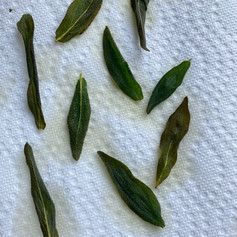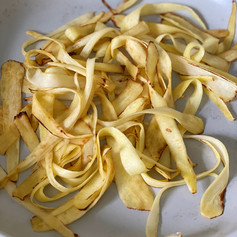A luscious bowl of pasta that fools the eye but delights the tastebuds.

This is one of the most luxurious yet simple, sophisticated yet approachable pasta dishes you'll ever taste. It's the ultimate restaurant dish that you can prepare entirely from scratch at home. Every step of the process is all about technique, not torture, about building upon layers of flavor. From the preparation of the pasta dough to the steeping of the cream with sage, from the shaving of the parsnips, to the the dry-sautéing of the mushrooms, this dish demands the efforts of an enthusiastic cook. Even the garnish of fried sage leaves is all about technique. Don't let any of this deter you! It just means that the recipe is procedural. If you follow the procedure, the reward will be a seductively good bowl of exquisite pasta.
Essential equipment: dry and wet measuring cups; measuring spoons; fork; plastic wrap; rolling pin; pizza wheel; rimmed sheet pan; small saucepan; small sauté pan; tongs; cutting board; chef's knife; peeler; wooden spoon; large saucepan or stockpot; large and deep sauté pan; ladle; colander or strainer

Pasta Dough Ingredients:
2 cups all-purpose flour
1 teaspoon kosher salt
3 large eggs
Sauce Ingredients:
1½ cups heavy cream 24 fresh sage leaves, divided in half
¼ cup olive oil 1 pound shiitake mushrooms, stems removed
4 large parsnips
½ cup grated Parmesan, plus extra for garnish freshly ground black pepper to taste
pinch of salt to taste
1. To prepare the pasta, place the flour in a mound on a clean kitchen counter, stir in the kicker salt, and make a well in the middle. Add the eggs and beat with a fork. Gradually draw the flour into the eggs using the fork until a sticky dough begins to form.
2. Once a dough forms, abandon the fork and begin to use your hands to shape the dough. At first the dough will be rough and crumby, but after ten minutes of kneading, the dough will be much smoother.
3. Cut the dough into four pieces and wrap each piece in plastic wrap. Set aside for one hour before rolling and cutting.
4. After one hour, roll one piece of dough to an 1/8-inch thick rectangle, turning the dough over potentially several times as you roll to aid in making it thin enough to see the outline of your hand.
ILOC tip: you will not need to flour your work surface to roll the pasta dough, but if you feel that you need some flour be sure that it is a very light dusting at best.
5. Trim the dough, if desired, using a pizza wheel or a chef's knife and discard the scraps. Cut ¾-inch strips to make the pappardelle. Place the pappardelle on a sheet pan lined with plastic wrap and set aside. Repeat with the remaining three pieces of dough, using more plastic wrap as needed to layer the pappardelle on the sheet pan. Let the pasta rest while you prepare the remaining ingredients.
ILOC tip: if you want to prepare the fresh pasta in advance, this is the point at which you may freeze the noodles. Proceed with the recipe when you wish to serve it.
6. Place the heavy cream in a small saucepan along with 12 sage leaves. Place the pan over medium heat. Once the cream comes to a simmer, remove the pan from the heat and set aside for 20 minutes to steep. After 20 minutes, remove the sage leaves and discard. Set aside the pan of cream.
7. To prepare the fried sage leaves for garnish, heat a small pan over medium-high heat. Once hot, add the olive oil and the remaining sage leaves, using the tongs to flatten the leaves to prevent them from curling. Fry the sage leaves for approximately 30 seconds per side, or until the sage leaves change color and bubble. Immediately drain the sage leaves on a paper towel and set aside. Reserve the oil used to fry the leaves.
8. Slice the shiitake mushrooms to ¼-inch slices. Heat a large sauté pan over medium-high heat and add the mushrooms to the dry pan. Cook the mushrooms for 3-4 minutes per side, in batches without crowding the pan, so that the mushrooms become lightly browned without releasing their moisture. Set aside.
"The point of dry-sautéing the mushrooms is threefold: 1. give the mushrooms a lightly browned color. 2. keep the mushrooms from releasing their moisture so that the finished dish is creamy and not watery. 3. ensure that the mushrooms hold their shape to add bite and textural dimension."
9. Peel the parsnips of their dark, outer skin and discard the scraps. Using the peeler, make ribbons that mimic the approximate width of the pappardelle. Peel the parsnips two strokes at a time and then turn the parsnip one quarter rotation. Repeat with two peels, and then rotate the parsnip again so that that the parsnip resembles a square column with four sides. Peel in this fashion and pattern - two strokes per side - until it is no longer feasible to get pappardelle-esque ribbons. Save the excess parsnips for another use (soup, purée, sauté). Set aside the parsnip ribbons.
10. In a large saucepan or stockpot, bring to a boil water filled 2/3 of the way plus 1 tablespoon salt. Once boiling, add pappardelle. Stir gently with a spoon or tongs to prevent the pasta from sticking to the pan. Cook for 6-7 minutes, or until the pasta is al dente, slightly toothsome but tender.
ILOC tip: once the pasta is added to the boiling water, the water temperature will drop and then rise again quickly. Manage the heat as needed so that the water ultimately comes back to a simmer but does not boil over and spill onto the stovetop.
11. While the pasta cooks, heat the large sauté pan used for the mushrooms over medium-high heat. Add the reserved sage-frying oil to the pan. Swirl to coat and add the parsnip ribbons. Sauté for 2-3 minutes until softened and barely browned.
12. Add the sage cream to the parsnips. Mix well to coat and bring to a simmer. Once bubbling, add in the cheese and stir. Then add the mushrooms and a generous pinch of kosher salt, and mix well to combine. Remove the pan from the heat to pause while you attend to the pasta.
13. Drain the pasta and shake off any excess water, but do not rinse in cold running water. Add the noodles to the pan with the parsnips, cream, and mushrooms, tossing well to coat.
ILOC tip: do not rinse the pasta in cool running water once drained because, in part, the pasta is immediately being added to the sauce. Also, the starch on the pasta helps the cream adhere to it.
14. Divide the pappardelle among four shallow bowls, sprinkle generously with freshly ground black pepper, and sprinkle with additional cheese if desired. Garnish each portion with three fried sage leaves. Serve immediately.
Makes 4 servings.











































































































Comments